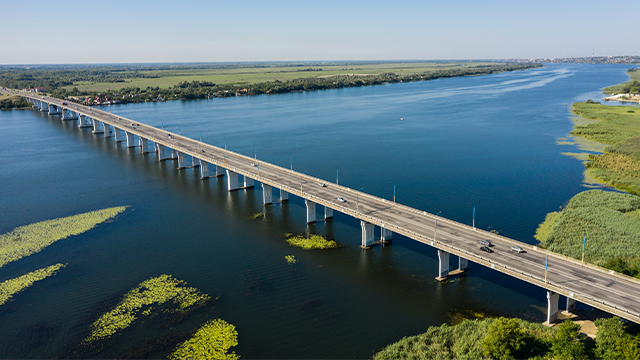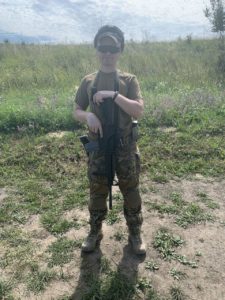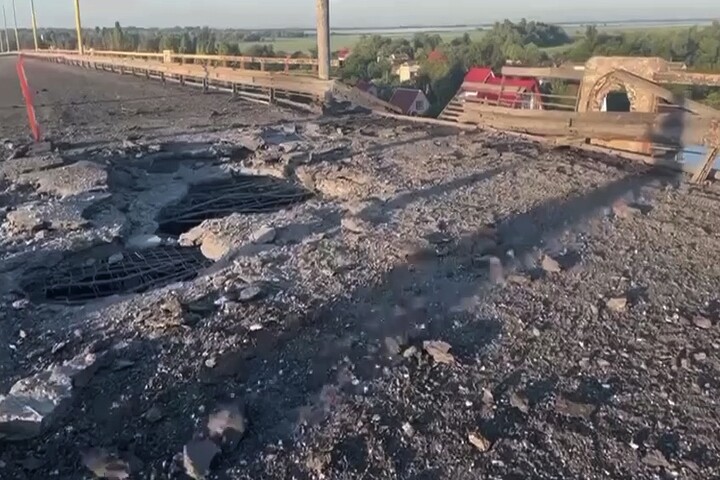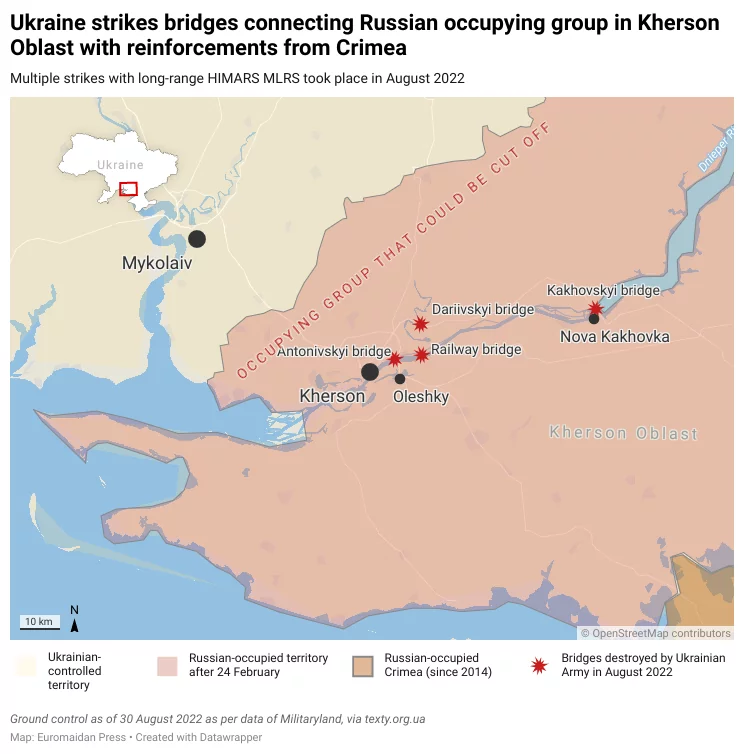
All Ukrainian military personnel currently fighting for Ukraine’s freedom are heroes in the eyes of Ukrainian citizens, but only a few are recognized as such by the state. Dmytro Chavalakh was honored for his valor and service after his battalion came face-to-face with Russian paratroopers trying to seize Antonivskyi Bridge. It was up to him to lead his unit to safety.
Realization that this was going to be a full-out war

The unit in which Dmytro was serving was relocated to the city of Oleshky in the Kherson Oblast beginning in February 2022. This was the same spot where senior lieutenant Dmytro Chavalakh met a violent dawn on 24 February due to missile assaults on his and his battalion’s post.
“When I first heard the sound of powerful explosions, I couldn’t believe our positions were being attacked,” told the young Ukrainian soldier. Instead, Dmytro was certain that Russian soldiers were engaging in disorganized shelling in order to create tension in this area and force the Ukrainian Armed Forces command to transfer extra battalions there, thereby withdrawing them from Donbas and stretching them thin. “I was certain that the fighting would be contained to Donbas.”
However, when he heard the Russians had broken through the Crimea checkpoint lines and were rapidly advancing into the Kherson oblast, he realized that this war was something else. It was going to be a full-out war.
Dmytro knew that for the Russians to reach Kherson, they had to take the Antonivskyi bridge. If Ukrainian troops could get to the bridge and create a strong enough defense, they knew they could halt Russia from taking the regional center. However, on their way to the bridge to assume their positions, they were subjected to missile fire by enemy fighter jets.
Russia’s takeover of Antonivskyi Bridge, Kherson
Ukrainian soldiers were slowed down by the constant rain of aviation fire, and, as it turned out, were too late. Russian troops had arrived at the Antonivskyi Bridge by helicopters from Crimea.
When the brigades moved closer to Kherson, the Russians opened devastating mortar fire on them, forcing the Ukrainians to retreat; they were surrounded. One unit of Russian troops was advancing from Crimea, and another was commanding the key bridge on the Dnieper river’s right bank.
The Kherson “referendum” sham: out of the Kremlin’s hybrid war playbook
They had one choice to survive. The Antonivskyi bridge had to be unblocked.
The brigade’s tank company was the first to go. Despite setbacks, they gained a foothold on the opposite side of the bridge. “My battalion and I were next to go in and ‘clean up.’ While the tankers provided us with as much cover fire as possible, our infantry suffered its first casualties,” said Dmytro.
“It was a dual of the tanks. Heavy fire, a constant forward and back. The Russians were quickly running out of artillery as we started to break their lines. It was deafening; shelling was ringing in the air as we made our approach down the bridge. But the closer we got, we could see something strange happening. As we made it closer, the Russians just stopped, abandoned all of their artillery, and retreated,” told Dmytro.
The “clean-up” went on for several hours, but what was clear was that Russian paratroopers lacked combat experience.
It was a dual of the tanks. Heavy fire, a constant forward and back Click To Tweet“They were making mistakes you wouldn’t expect to see by trained army soldiers,“ Dmytro continued. “For example, they stationed their military equipment directly on the bridge, making it an easy target, fired haphazardly, and had no idea how to cover each other.”
Dmytro told how near the bridge stood several country houses, which became a refuge for the surviving Russian soldiers.
“They threw grenades and opened fire with small guns,” Dmytro explained, still bewildered by their tactics.
After reaching the empty tankers, Ukrainian infantry took a moment to reload their weapons, assess the situation, and take up their carefully selected battle positions.
Dmytro’s unit opted to establish a foothold by a railroad near the Antonivskyi bridge, setting up a defense there until the remainder of the brigade’s unit crossed the bridge into Kherson.
A sniper’s prey
During one of the multiple Russian military attacks on the Antonivskyi bridge, Dmytro was seriously wounded by a direct hit from a Russian sniper.
“Something felt fiercely painful in my groin. Snipers turned their attention to us. Given the frequency of the shots, there had to be at least three of them. We started firing on one hiding behind the gas shield near the petrol station, and the shots coming from his direction quickly became silent. The other two, however, were never found.
I have no memory of how I got wounded. Everything was happening so quickly. I was ‘riding high on adrenaline.’ But then I blacked out.”
Dmytro was then taken to a hospital in Kherson and operated on. When he regained consciousness, physicians informed him of the news: Kherson was under Russian military occupation.
For three months, this Ukrainian soldier had been hiding in the homes of local patriots. Finally, he and his troops withdrew from the captured city. His unit has since been moved to Mykolayiv, the town bordering Kherson, and is still fighting the Russian army.
Kherson, Antonivskyi bridge and its future?
Dmytro is certain that Russian forces in the Kherson oblast remain extremely vulnerable. Both banks of the Dnipro River are only 60 meters apart and are connected by two bridges: Antonivskyi and the bridge over the Kakhovka Hydroelectric Power Plant dam.
When Ukrainian artillery used HIMARS systems to bomb the Anonivskyi bridge, it became clear that Russia could not fully support its groups on the right bank in the Kherson oblast. Destroying the possibility of using the Anonivskyi bridge means cutting Russians off from their main grouping.

Now that Ukraine has fire control over all Dnipro crossings, which are used by the right-bank enemy group, Ukrainian forces can launch active counter-offensive operations. This is evidenced by Ukrainian forces breaking Russia’s front lines as of the last week of August.
Additionally, Hundreds of villages in the Kherson oblast have recently been liberated from Russian occupation. Russian troops are spread out over a large area, subjecting them to a logistical nightmare of resupplying their ammunition.
The Ukrainian army’s tactics are not yet clear, but it is not advancing with huge numbers. Instead, they are focusing their efforts on the enemy’s vulnerable defense points. This will potentially result in a breakthrough, gaining a foothold on critical positions, and gradually, but with minimal loss, expand Ukraine’s area of control, cutting off all routes of logistical supplies.
As Dmytro’s account demonstrates, the Russians were unprepared, and their war strategy was limited to old-school Soviet patterns such as frontal assaults. As he believes, the Russian army manages to have an edge exclusively because of the sheer amount of artillery and ammunition, but in regular infantry battles, the Russians are deeply inefficient and weak.
According to recent intelligence reports, the Russians are reinforcing their groupings in Kherson Oblast with units previously located in Donbas. They are paying the most attention to fortifying their positions near Nova Kakhovka and further south, as the North Crimean Canal begins here, a critical object. Without the Canal’s water, the peninsula will quickly devolve into a Sahara Desert situation. As a result, it is expected that the Russian command will go to any length to defend the Kherson oblast.
Both sides are gearing up for some of the most decisive battles of this war to date, but Ukrainian Hero, Dmytro, believes that if the Ukrainian Armed Forces successfully counter-attack Russians in the Kherson Oblast, the war’s trajectory will change in Ukraine’s favor.
Read more:
Ukrainian troops launched counteroffensive in Kherson Oblast – media (updated 22:47)
The battle for Kherson Oblast: dispatch from the hot zones of war
Threatening Kherson farmers, Russian troops steal grain from Ukraine
The Kherson “referendum” sham: out of the Kremlin’s hybrid war playbook





